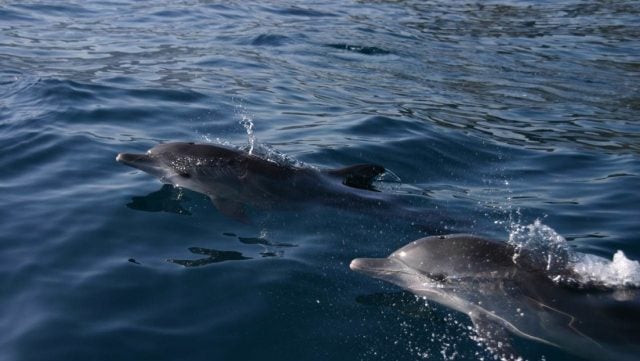Years of research on the warm Venezuelan coasts have shed light on the behavior of dolphins and their social grouping, where a matriarch dominates, just as it happened centuries ago in human societies, according to some theorists.
In addition to these findings, as a result of the meticulous study of these cetaceans, some questions arise: Are they intelligent? Do they have culture? Do they ‘talk’ to each other? Do they feel?
In Venezuela there are 15 species of dolphins, four or five of whales, two of sperm whales and three of beaked whales (dental cetaceans that live about 400 meters deep).
The Venezuelan biologist and professional associated with research at the Venezuelan Institute of Scientific Research (IVIC), Sergio Cobarrubia Russo, has spent 20 years studying the behavior of dolphins on the coast of Aragua state, in the center of the country, just one hour from Caracas.
During the decades of his research, Cobarrubia has traveled 1.5 kilometers parallel to the coast, from the mouth of Turiamo Bay to Uricao Beach, both in Aragua and separated by almost 20 kilometers, to study the bottlenose dolphin ‘Tursiops truncatus‘ and the spotted dolphin ‘Stenella frontalis’, which co-inhabit the area.
A rigorous task
When groups of cetaceans are sighted, the meticulous record of each one of them begins. To do this, among other things, Cobarrubia observes their behavior and photographs their dorsal fins, which are unique and represent a kind of «fingerprint». to establish your identity.
Cobarrubia studies the social structure of these dolphins, their social networks, their forms of verbal and bodily communication. This information is poured into a database where the number of individuals, residence and survival times in each area, among other data, are collected.
In addition, he analyzes the social organization, mainly matriarchal, of the dolphins. In the same way, he seeks to see how they are structured, how they are connected in a social network, who has the greatest number of social ties and the greatest political dominance, that is, which ones relate more with its peers.
To learn more about these aquatic mammals that swim in Venezuelan waters, the biologist from the IVIC Ecology Center explains to RT several aspects that he has found about them during his research over two decades.
Is there a dolphins matriarchy?
Dolphins are organized as a matriarchy. In the case of females, they probably remain in the same matriarchal group all their lives, colonizing an adjacent area and sharing space with other groupings, or moving in with a neighboring herd.
In the families, there are two or three grandmothers, who are the ‘heads’ of the family. There, the daughters, nieces, offspring and one or two ‘visiting’ males live together.
There are some matriarchies that are not totally strict and there are usually one or two males ‘visiting’ it. When they are maturely sexual they leave the group and must take care of themselves.
The role of male dolphins
As they mature sexually, males become «unbearable» by the process of hormone generation. For this reason, they are execrated from the matriarchy and form groups of «high schoolers», who are very aggressive, tend to be outcasts and have violent behavior. There, alliances of two or three individuals are formed —who have certain family ties and are usually cousins—, which last a lifetime.
These inseparable companions visit the matriarchies, which are found along the entire coast to leave their genes in the reproductive seasons, which correspond to December, January and February.
What happens when the matriarch is missing?
When a matriarch dies, in terms of the hierarchy, it is possible that the oldest ones take her place, as occurs in sperm whales and African elephants. This also impacts the position that the intermediary will have from that moment on, who handles more information than others, without necessarily being a hierarch.
It has been seen in New Zealand that when the second dolphin that handled the most information disappears, the one that was in third place takes its place, and so on. There is always a spokesperson and a substitute, the ‘post’ cannot be left empty.
What are their social networks like?
Cobarrubia explains that by photographing several dolphins in a given area, their daily interactions can be observed. When analyzing them, the groups and members who have intragroup and intergroup contact can be observed,and this allows me to determine who has more social connections and who are the matriarchs.
As for the family group, you can see the intermediaries, the most sociable individual, the political leader and the head of the group.
How do they ‘know’ the information they share?
The grandmothers and mothers manage both the information they learned during their upbringing, as well as the information that corresponds to the time they have lived in a certain area. They pass this on to their young.
Breeding in dolphins is similar to that of humans because many years of information provided by the mother are needed: place of birth, places to sleep, eat, socialize and dangers in the presence of predators.
What information do dolphins transmit?
There is information on the biological interpretation, which could be related to the availability of shelter, food depending on the season, the presence of predators such as sharks, mainly.
How do they communicate?
The forms of communication are varied. One of them are the ‘whistles’ that, although what they say has not been determined, serve to socialize.
Six types have been identified:
– Constants.
– Ascendants.
– Descendants.
– Ascending-descending (they predominate during the trip and are not emitted during socialization).
– descending-ascending.
– Multiple.
The ‘click’ is another way of expression that they use when they go hunting, and they do not have visibility in the water. They do this to determine the distance of objects when they reflect the sound they emit.
Also, when approaching the prey, they emit a ‘chain of clicks‘ and the more frequent they are, the better the mental image of their ‘food’.
Are they intelligent?
Dolphins have a good memory. When navigating underwater, they must know their surroundings because they live in a three-dimensional environment, they use their sight and hearing to locate themselves.
The biologist Guillermo Barreto together with the journalist Nerliny Carucí affirm in an article by Ciudad CCS that dolphins «are animals with a highly developed nervous system, which show complex behavioral patterns».
In a publication of the Museum of Natural History of Chile, it is stated that dolphins have «self-knowledge and self-monitoring», which means that they are able to recognize themselves if they see themselves in a mirror. In the same way, they «understand the instructions of the language», «show an understanding of the symbolic» and «how things work or how to manipulate them».
Do they have feelings?
Cobarrubia affirms that although he does not want to sound anthropocentric, it is possible to speak of feelings. To illustrate, he says that when mothers lose a newborn dolphin, they carry its lifeless body with them for a week. They also have epimethetic behavior, which occurs when an individual is related to the care of others.
Do dolphins have culture?
Culture in cetaceans exists and is considered as the transmission of information so as to live.
An example of this, is that there are dolphins in Australia that use the sponge as a fishing tool. Although this is practiced by children whose mothers taught it to them in a vertical sense (Mother to child), this information can also be transmitted horizontally to the partner who imitates their behavior when they see it.
The biologist details that there is a debate among anthropologists, who consider that culture is only limited to human beings. However, when studying the bottlenose dolphin, it is observed that it has the possibility of leaving the pod and returning, even moving from one group to another. «It’s like a cultural and information exchange».
Can they live isolated?
When in a water park a dolphin is the main attraction of the place, those who applaud his pirouettes ignore that this place could end his life. “It is a tragedy for those who remain and for those who leave, because you take a totally social animal out of its environment, which is in constant communication all the time”, says Cobarrubia.
«When you capture an animal, it’s like they take you out of your family, confine you to solitude and break the social bond, which is very strong, even stronger than ours», he adds.
To exemplify, he refers to a study that was done in the Bahamas with spotted dolphins, which are very sociable, and which showed that in a season that saw two hurricanes, where 30% of the population died, the average social bond increased, which happened from 0.5% before the weather event to 0.8%. «The climatic disturbance made social ties stronger», adds the Venezuelan researcher.













